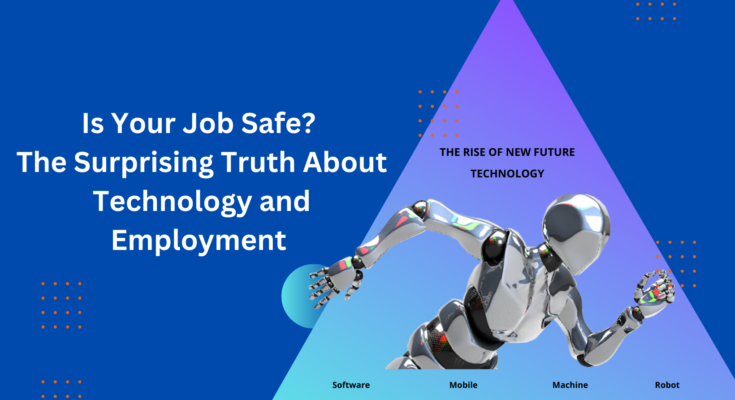The impact of technology on employment is a topic of significant debate. As we navigate through the digital age, understanding how technological advancements influence job markets is crucial. This blog post delves into the multifaceted relationship between technology and employment, exploring both the positive and negative effects.
Discover the dual impact of technology on employment in our comprehensive blog post. Explore how advancements create new job opportunities while displacing traditional roles. Learn about the rise of the gig economy, the importance of reskilling, and the role of supportive policies. Uncover the future outlook for jobs in the digital age and find out if your job is safe from automation. Stay informed and prepared for the evolving job market with insights and data on the intersection of technology and employment. Read on to navigate the challenges and opportunities of the tech-driven world.
Introduction
Technology has been a driving force behind economic growth and societal transformation. From the Industrial Revolution to the Information Age, technological innovations have continuously reshaped the way we live and work. However, the question remains: does technology help or hurt employment? This blog post aims to provide a comprehensive analysis of this question, supported by data and expert opinions.
The Historical Context
Historically, technological advancements have led to both job creation and job displacement. The Industrial Revolution, for instance, saw the rise of factories and mass production, which created numerous jobs but also rendered many traditional crafts obsolete. Similarly, the advent of computers and the internet revolutionized industries, creating new job categories while eliminating others.
Job Creation Through Technology
- New Industries and Job Roles: Technology has given birth to entirely new industries. The rise of the tech industry itself is a prime example, with roles such as software developers, data scientists, and cybersecurity experts becoming essential. The renewable energy sector, driven by advancements in technology, has also created jobs in solar and wind energy.
- Increased Productivity and Efficiency: Automation and artificial intelligence (AI) have significantly increased productivity and efficiency in various sectors. This has led to the creation of jobs that focus on managing and improving these technologies. For instance, the implementation of AI in healthcare has created roles for AI specialists and data analysts who work on improving patient care through technology.
- Gig Economy and Remote Work: The internet and digital platforms have facilitated the growth of the gig economy and remote work. Freelancers, remote workers, and digital nomads are now common, thanks to platforms like Upwork, Fiverr, and remote collaboration tools. This shift has provided employment opportunities for individuals who prefer flexible working conditions.
Job Displacement Due to Technology
- Automation and AI: While automation and AI have created jobs, they have also displaced many. Routine and repetitive tasks are increasingly being automated, leading to job losses in sectors such as manufacturing and customer service. A study by MIT found that since 1980, technology has replaced more jobs than it has created in the U.S…
- Skill Mismatch: Technological advancements often require new skills that the existing workforce may not possess. This skill mismatch can lead to unemployment or underemployment for those who cannot adapt. For example, the transition to digital banking has reduced the need for traditional bank tellers, while increasing the demand for IT professionals.
- Economic Inequality: The benefits of technological advancements are not evenly distributed. High-skilled workers in tech-savvy industries often see wage increases, while low-skilled workers may face job insecurity and wage stagnation. This disparity can exacerbate economic inequality.
Some Statistics on Job Displacement Due To Technology
Here are some key statistics on job displacement due to technology:
- Automation Impact: By 2030, it’s estimated that around 39 million Americans could lose their jobs due to automation. This is largely because 50% of hours spent on manual work-related tasks could be automated based on the current speed of technology adoption1.
- Global Job Displacement: Worldwide, automation could lead to the displacement of 85 million jobs by 2025. This significant shift underscores the need for reskilling and upskilling to adapt to new job requirements.
- Industry-Specific Changes: In industries adopting automation, the average job displacement from 1947 to 1987 was 17%, with a reinstatement rate of 19%. However, from 1987 to 2016, the displacement rate was 16%, while the reinstatement rate dropped to 10%. This indicates a growing challenge in creating new job opportunities to replace those lost to automation.
- AI and Job Impact: According to the World Economic Forum, around 40% of all working hours could be impacted by AI and large language models like ChatGPT-4. This includes a significant reduction in clerical and secretarial roles, while increasing demand for AI specialists, data analysts, and digital transformation experts.
These statistics highlight the profound impact technology can have on employment, emphasizing the importance of proactive measures such as reskilling and supportive policies to mitigate job displacement effects.
Balancing the Scales: Policies and Education
- Reskilling and Upskilling: To mitigate the negative impacts of technology on employment, reskilling and upskilling programs are essential. Governments and organizations need to invest in training programs that equip workers with the skills needed for the jobs of the future. For instance, initiatives like coding bootcamps and online courses can help workers transition into tech-related roles.
- Supportive Policies: Policymakers play a crucial role in ensuring that the transition to a technologically advanced economy is smooth and inclusive. Policies that support job creation, provide social safety nets, and encourage innovation can help balance the scales. For example, tax incentives for companies that invest in employee training can promote workforce development.
- Lifelong Learning: The concept of lifelong learning is becoming increasingly important. As technology evolves, continuous education and skill development are necessary to stay relevant in the job market. Educational institutions need to adapt their curricula to include emerging technologies and digital skills.
Case Studies
- Manufacturing Industry: The introduction of robotics and automation in manufacturing has led to significant changes. While some jobs have been lost, new roles in robot maintenance, programming, and supervision have emerged. Companies like Tesla and BMW have integrated advanced robotics into their production lines, creating high-tech job opportunities.
- Healthcare Sector: Technology has revolutionized healthcare, from electronic health records to telemedicine. These advancements have created jobs in health informatics, telehealth services, and medical device development. However, they have also reduced the need for certain administrative roles.
- Retail Industry: E-commerce and automation have transformed the retail industry. While traditional retail jobs have declined, new opportunities in logistics, digital marketing, and customer service have arisen. Companies like Amazon have created thousands of jobs in their fulfillment centers and tech departments.
The Future Outlook
The future of employment in the age of technology is both promising and challenging. Emerging technologies such as AI, blockchain, and quantum computing have the potential to create new industries and job roles. However, they also pose the risk of further job displacement and economic inequality if not managed properly.
Conclusion
In conclusion, technology has a dual impact on employment. It creates new opportunities and industries while displacing certain jobs and skills. The key to harnessing the benefits of technology lies in proactive measures such as reskilling, supportive policies, and continuous learning. By preparing the workforce for the future, we can ensure that technology serves as a catalyst for positive change in the job market.
Frequently Asked Questions
- How does technology create new jobs?
- Technology creates new jobs by fostering the development of new industries and roles, such as software development, data analysis, and cybersecurity. It also enhances productivity, leading to the need for roles that manage and improve technological systems.
- What types of jobs are most at risk due to automation?
- Jobs involving routine and repetitive tasks, such as manufacturing, data entry, and customer service roles, are most at risk of being automated. These tasks can be efficiently performed by machines and AI systems.
- How can workers adapt to technological changes in the job market?
- Workers can adapt by engaging in continuous learning and upskilling. This includes taking courses in emerging technologies, participating in training programs, and gaining certifications in relevant fields.
- What is the gig economy, and how has technology influenced it?
- The gig economy consists of short-term, flexible jobs often facilitated by digital platforms like Uber, Upwork, and Fiverr. Technology has enabled the growth of this economy by providing platforms that connect freelancers with clients globally.
- Are there any sectors where technology has created more jobs than it has displaced?
- Yes, sectors such as information technology, renewable energy, and healthcare have seen significant job creation due to technological advancements. These sectors require specialized skills and have benefited from innovations.
- What role do governments play in managing the impact of technology on employment?
- Governments can implement policies that support job creation, provide social safety nets, and promote reskilling and upskilling programs. They can also incentivize companies to invest in workforce development.
- How does technology contribute to economic inequality?
- Technology can contribute to economic inequality by disproportionately benefiting high-skilled workers while displacing low-skilled workers. This can lead to wage disparities and job insecurity for those unable to adapt to new technological demands.
- What are some examples of jobs created by advancements in AI?
- Advancements in AI have created jobs such as AI specialists, machine learning engineers, data scientists, and AI ethicists. These roles focus on developing, implementing, and managing AI systems.
- Can technology improve job satisfaction and work-life balance?
- Yes, technology can improve job satisfaction and work-life balance by enabling remote work, flexible schedules, and automation of mundane tasks. This allows workers to focus on more meaningful and engaging activities.
- What is the future outlook for employment in the age of technology?
- The future outlook is mixed, with both opportunities and challenges. While new technologies will create jobs and industries, they will also displace certain roles. Continuous learning, supportive policies, and proactive adaptation are key to navigating this landscape.
-
Can the Second Wife Claim a Deceased Government Employee’s Pension?
Family pension rules can be challenging, especially when it involves the second wife of a deceased government employee. This comprehensive guide aims to provide clarity on this topic, ensuring you …
-
Axis Bank re-appoints Amitabh Chaudhry as MD & CEO of bank for 3 years
Axis Bank on Thursday reappointed Amitabh Chaudhry as the Managing Director and Chief Executive Officer of the bank for the next three years starting January 1, 2025.
-
Road ready for multilateral banks to meet funding needs: Finance Minister Nirmala Sitharaman
Finance MinisterNirmala Sitharamanhas said a “pathway has been successfully built” to enable multilateral development banks (MDBs) to better address global challenges and financing requirements.. Participating in the fourth meeting of …
-
Overhang for Axis Bank over, Amitabh Chaudhry secures re-appointment from RBI
MUMBAI: Private sector lenderAxis Bankon Thursday said that theReserve Bank of Indiahas approved there-appointmentof its chiefAmitabh Chaudhryfor three years. The bank’s board had applied in April to the RBI to …
-
Partha Pratim Sengupta to lead Bandhan Bank as Managing Director and CEO from November 1
Partha Pratim Senguptawill leadBandhan BankasManaging DirectorandChief Executive Officerfrom November 1, the Bank announced on Friday.. The decision was made public after the Reserve Bank of India gave its nod to …
-
Credit growth for banks to moderate to 12 percent in FY25: Icra
Ratings agencyIcraanticipates a steady slowdown incredit growthfor banks and non-bank financial companies (NBFCs) on account ofregulatory measuresand tighter funding conditions in the domestic markets. The agency estimates the incrementalbank creditgrowth …






